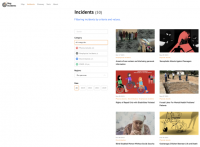 The monitoring group of
the School of Peacemaking has presented analytical results of the documented
incidents.
The monitoring group of
the School of Peacemaking has presented analytical results of the documented
incidents.
The research data was collected in 2023 by both specialist researchers and monitoring methods using open-source content in the Kyrgyz and Russian languages.
The Mapincidents in Kyrgyzstan is an open data resource, a tool for analyzing the situation and collecting cases. Statistics in the Incidents section display the number of incidents for each individual category.
This web resource displays only facts that have been documented by experts from the School of Peacemaking, the Coalition for Equality in the Kyrgyz Republic and have a certain context in the form of a media story. Many incidents remain unknown for various reasons. Based on the collected information, various reports are compiled. The final 2023 report will be published in 2024.
Photo: Screenshot of the web resource mapincidents.net
The report shows the results of monitoring, documenting and case analysis related to discrimination and violence during the coronavirus pandemic, as well as the study of hate speech against minorities and vulnerable groups in the selected online content.
The report contains the data that cover the period from February 15, 2020 thru March 10, 2021.
The study represents the analysis of cases relating to eleven vulnerable social groups:
· female victims of violence and abduction;
· persons with disabilities, including inmates;
· internal migrants;
· labour migrants;
· the elderly people;
· people living with HIV;
· LGBT people;
· children under 15;
· foreigners victims of racial attacks;
· Muslims;
· ethnic Chinese
In addition, the report contains a separate subsection with the case of Kamil Ruziev, the human rights defender based in Karakol, Issyk Kul region. He was arrested in May 2020 on a reasoned charge and was morally coerced, surveilled and illegally questioned even though he was ill with COVID-19.
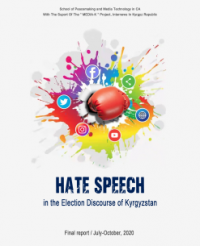 From July 15 to October 10, 2020, the experts of the School of
Peacemaking and Media Technology in CA conducted the "Hate Speech in the
Election Discourse of Kyrgyzstan” study with the support of the USAID-funded Media-K
project and Internews in the Kyrgyz Republic.
From July 15 to October 10, 2020, the experts of the School of
Peacemaking and Media Technology in CA conducted the "Hate Speech in the
Election Discourse of Kyrgyzstan” study with the support of the USAID-funded Media-K
project and Internews in the Kyrgyz Republic.
To successfully counteract hate speech and discrimination during election campaigns, it is necessary to improve the culture of discussion and self-expression and create models for politically correct discourses in the public space and media sphere of Kyrgyzstan.
Diagram 1. Dynamics of detected hate speech over all seven periods of media monitoring, %
The researchers analyzed the trends and dynamics of hate speech detected in the selected online media and social media content. This content was classified by type, and the team identified ten prevailing trends and their causes in each period of media monitoring. Detailed analysis of these trends is provided in the final report.[1]
Diagram 2. Dynamics of trends by kinds of intolerance in media and online discussions in all periods, %
In their main findings, researchers noted
- the lack of quality analytical information about political parties and their platforms and candidates in the media;
- the use of hate speech in relation to the most sensitive issues for the audience on the internet and in the public sphere;
- references to the ethnic and regional affiliations of candidates and their supporters;
- language intolerance in discussions about debates; and
- gender imbalances and hate speech directed at female candidates on social media.
During the study, researchers also recorded instances of trolling, flawed argumentation and identification, accusations toward political parties and their candidates of association with someone else, divisive language, and obscene and coarse language. These phenomena were also detected in visual content.
The experts emphasize that statements and quotes in the election discourse that contained xenophobia created a demand for xenophobic content among the audience, which was expressed in the form of intolerant comments in the forums under news items published online and on social media.
The researchers recommend that authorities:
- take the September 2020 UN Strategy and Plan of Action on Hate Speech into account when developing programs;[2]
- facilitate the speedy adoption of a comprehensive anti-discrimination law in the Kyrgyz Republic;
- develop multilingual models for debates among candidates and public officials;
- train speakers to avoid hate speech and intolerance during election campaigns.
The study authors also urge donor and other international agencies to support ongoing professional monitoring and humanitarian examinations of hate speech in public discourse as well as efforts to develop a new media culture that promotes awareness of non-discrimination in public space and the importance of counteracting hate speech and that supports freedom of expression.
The study’s key recommendations are directed toward journalists and the media. These recommendations focus on the need to update editorial standards, institute exit polls to promote alternative options and develop critical thinking in the audience, and establish rules for quoting speakers who use hate speech in their statements.
"Journalists need to raise public awareness of the language of aggression in the online environment and its impact. It is important to understand network etiquette in online discussions by training voters to perceive the information they have consumed critically,” the recommendations emphasize.
This research has been made possible by the support of the American people provided via the United States Agency for International Development (USAID). The School of Peacemaking and Media Technology in CA is responsible for the content of the publications, which does not necessarily reflect the opinion of USAID, the US Government, or Internews in the Kyrgyz Republic.
About the organization. The School of Peacemaking and Media Technology in Central Asia is an organization for the development of media, public relations, the promotion of freedom of expression, and fighting hate speech and discrimination in the mass media. This organization specializes in media research and expertise on online content; the language of intolerance in the media, the internet, and public discourse; developing media campaigns on sensitive topics; and training journalists, online content developers, and human rights defenders, including in conflict zones.
https://www.facebook.com/peacemakingS/;
[1]Trends by kinds of intolerance, p. 28 of the final issue.
[2] UN Strategy and Plan of Action on Hate Speech, 2020, https://www.un.org/en/genocideprevention/documents/UN%20Strategy%20and%20PoA%20on%20Hate%20Speech_Guidance%20on%20Addressing%20in%20field.pdf, https://www.un.org/en/genocideprevention/documents/advising-and-mobilizing/Action_plan_on_hate_speech_RU.pdf
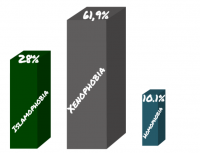 School of Peacemaking and Media Technologies has presented its interim report "Hate Speech in
Media, Internet and Public Discourse of Kyrgyzstan – 2015”.
School of Peacemaking and Media Technologies has presented its interim report "Hate Speech in
Media, Internet and Public Discourse of Kyrgyzstan – 2015”.
The report was based on the analysis of hate content carried in the surveyed print, broadcast, online media and social networks in Kyrgyz and Russian languages for November-December 2015 and data compared to other periods of the year, as well as the findings based on field studies.
The freedom of expression in the media scene of Kyrgyzstan is closely related to the lexis of hate, which is based on clearly xenophobic statements, political incorrectness and emphasizes poor journalistic standards in the media, while posts in social networks sometimes provoke network aggression. Despite the fact that Kyrgyzstan ranks higher in the Press Freedom Index[1], than the neighboring states in Central Asia, it still has problems with ethics.
The discriminatory language against minorities was also detected in those media outlets that describe themselves as analytical media. In their articles and reports about the problems faced by minorities, authors also create their negative image. Thus, the media contribute to the spreading of xenophobia – ethnic, religious, social and other types.
In 2015, the number of social groups that are seen as victims of hate speech and possible victims of hatred-based crimes has increased. If in previous years experts mainly identified definite ethnic groups, the analysis of the media sphere by the end of the year showed that the main target of hate speech in Kyrgyzstan are ethnic groups, Muslims and LGBT.
The project aims to monitor and analysis of hate speech in the media and public discourse, development of recommendations, and public outreach campaign to prevent violence and discrimination against minorities in order to protect human rights and basic freedoms.
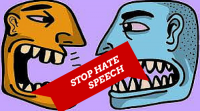 School of Peacemaking and Media Technology,
involved in media development and hate speech studies, has looked into the
debates and comments in media and on the web that appeared after some Russian
and local media outlets, online newspapers reprinted the article titled On Lions
and Jackals with the subtitle
Central State Channel in Kyrgyzstan Promotes Nazism.
School of Peacemaking and Media Technology,
involved in media development and hate speech studies, has looked into the
debates and comments in media and on the web that appeared after some Russian
and local media outlets, online newspapers reprinted the article titled On Lions
and Jackals with the subtitle
Central State Channel in Kyrgyzstan Promotes Nazism.
The article was published on 19 May 2015 both on the websiteand in Moskovsky Komsomolets-Asia newspaper. It discussed inappropriate statements of Abdrakhman Alymbaev, former chairman of the National Union of Writers of Kyrgyzstan and public figure, in a TV programme Tooluktardyn Tok Shousu (Highlanders Talk Show) broadcasted on OTRK in December 2014. The host and guest of the programme were discussing the differences between ethnic groups residing in Kyrgyzstan. The author of the article in MK-Asia accused Abdrakhmanov and OTRK of "voicing Nazi ideas”.
Also, a 4-minute video demonstrating a part of this TV programme was uploaded to YouTube on May 19, 2015.
Experts of School of Peacemaking and Media Technologyfound more than 150 short articles, posts, comments that discussed this topic in media and on the web last week. The majority of publications contained hate speech, xenophobic clichés and stereotypes, dehumanising metaphors concerning both parties. When quoting public speakers commenting on this issue, journalists conveyed hate speech, which had negative impact on both the audience and commentators that were immediately involved in the debate and used offensive language.
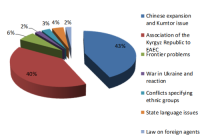 The Kyrgyz media celebrated World Press Freedom Day
2015 with relative freedom, under pressure from the political agenda, hate
speech, digital security challenges and cyber threats.
The Kyrgyz media celebrated World Press Freedom Day
2015 with relative freedom, under pressure from the political agenda, hate
speech, digital security challenges and cyber threats.
School of Peacemaking and Media Technology presented the report of freedom of expression in local media and on the internet. Experts emphasised the influence of social and political agenda on the media content. Analysis of the last four months identified 7 major topics covered mostly by the media. The majority of articles and posts were using hate speech. The leading topics covered in the media and on the internet were the Chinese expansion and Kumtor; almost the same number of stories, articles and posts raised the issue of accession of Kyrgyzstan to EAEC.
School of Peacemaking and Media Technology has presented its annual report "Hate Speech in the Media and Internet in Kyrgyzstan-2014”. The report was based on the analysis on hate content carried in the surveyed print, broadcasting and online media outlets published and issued in the country in Kyrgyz and Russian languages, which were classified according to perpetrators; victims; topics, genres, types of hate speech, stereotypes and clichés.
47 media outlets most popular among audience were selected for the study. Content analysis showed that more than one-third (36.1%) of media monitored contained hate speech. Almost 56% of all articles examined contained harsh and moderate hate language.
Classification by media types identified that in 2014 print media outlets included the majority of hate speech. 41.3% of newspapers monitored contained ad hominem attacks. Then follow online media, which 27.2% of hate speech rained down on the internet, and finally TV channelsgave of hate speech 1% only.
In 2014 compared to the previous year, general trends changed a little, and hate speech vocabulary showed some growth. Distinctive trend of 2014 were retranslating stereotypes and quoting by reporters of xenophobic connotations expressed by speakers in the political arena, media texts with dubious quotes with no editorial comments.
Author’s columns often contained harsh and moderate hate speech, direct and implicit forms for accusing an ethnic group of unwelcomed willingness to settle down in the region; creating negative image of an ethnic group by covering domestic conflicts and accusations of criminality.
Kyrgyz language newspapers top the list of hate speech producers; whereas online outlets top the list among Russian language media.
Hate speech in a wide range of topics
Hate speech creates negative public images of minorities, which proportion in media texts varies based on social and political events and media reflection. In 2014, hate speech was often contained in articles/stories covering discussions on historical and border topics, where ethnic groups were accused of criminality. Hate rhetoric was detected in topics covering the Kyrgyzstan’s reaction to relations between Russia and Ukraine and sanctions against Russia, participation of Kyrgyz nationals in the war in Syria, discussion about the Kyrgyz-Canadian JV Kumtor, investment projects of China in Kyrgyzstan, forthcoming accession of the country to the Eurasian Union.
 The analytical report shows that the number of hostile attacks in the network has increased by one fourth. Monitoring of Kyrgyz online content has shown that 56% of all articles and posts in social networks contain hostile comments and provocative calls.
The analytical report shows that the number of hostile attacks in the network has increased by one fourth. Monitoring of Kyrgyz online content has shown that 56% of all articles and posts in social networks contain hostile comments and provocative calls.
___Kibervrazhda-trend-sovremennyh-media-voyn.pdf The research data have been demonstrated at the presentation delivered at the 5th annual forum "Development of Web Sphere in Central Asia InternetCA-2014”.
For additional info please contact us at: ca-mediator@safe-mail.net

The School of Peacemaking and Media Technology in Central Asia announces an annual competition among students from Kyrgyzstan, Kazakhstan,…

25 journalists and media workers from various regions of Kyrgyzstan have been trained to counter the propaganda of violent extremism and hate in…